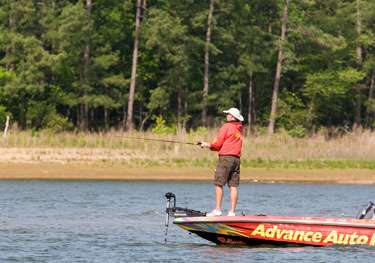
There was a time when no self respecting angler would consider launching his or her boat without one. It just wasn't done. But then, over time, other baits began to replace it. Carolina rigs, jigs, deep diving crankbaits and the like came into favor. The Texas rigged worm soon turned into a relic, something no real bass angler would throw.
"I don't really know why guys stopped fishing with them. They never really stopped catching bass," says Marty Stone, Bassmaster Elite Series angler and four-time Bassmaster Classic qualifier. "They just sort of fell out of favor for awhile.
"I think one reason was that they developed a reputation as a small bass lure. That, of course, is the kiss of death at the professional level. That reputation filtered down to recreational anglers which hurt them even more."
Stone readily admits their small bass reputation was honestly earned, but, at the same time points out that they'll catch plenty of big ones, too. That's a fact not lost on modern anglers, anglers who want to catch bass on a consistent basis and who could care less if their lure is modern or ancient so long as it works.
Stone — along with most top bass anglers — recommends upsizing to a 10 1/2-inch model if you want to cull smaller bass before they bite. Stone's first choice is a black Zoom Ol' Monster.
"You'll still catch a few small ones with it, but for the most part it'll attract keepers. And, it'll almost always attract the biggest bass in the lake, regardless of their size. For my money, I'd just as soon turn a few loose in between catching a hawg or two. That's a fair trade in my neighborhood."
Stone also points out that worms are good at almost any depth and under most fishing conditions. They can be worked in a few inches of water around grass, pads, rock or wood as easily as they can be worked along breaks and ledges beneath 30 feet of water.
Just as important, they'll provoke bites during any season or in any water temperature. Work them fast on days with a good bite or in warm water, and slow on days when strikes are hard to come by or in cold water. They may not always be the very best choice of lures, but they're rarely the worst choice.
It's a matter of giving the fish what they want on any given day. To find out what that is, Stone employs three basic presentations, no matter the season, the water temperature or the water's depth.
3 Basic Presentations
1. The classic lift and drop
"I like to cast it out as far as possible and then just lift and drop it. I'll pull it forward a few inches each time, and vary the height of the lift and the length of the pause, until my worm is out of the strike zone."
2. The simple drag
"At times I'll try dragging it along without letting it lose contact with the bottom. Again, vary the speed and length of your drag, and rest your bait from time to time. Be careful when you do this not to move it too far or too fast. That's easy to do if you're not paying close attention to what's going on."
3. Wiggle it in place
"Sometimes simply shaking your wrist a little and letting the worm wiggle in place will generate bites. I sometimes use this as my primary retrieve, but at other times I'll do it in combination with the lift and drop or the drag."
Choosing worm tackle isn't all that tough, but you do need to pay attention to the details.
Stone arms his worm with a 5/0 round bend off-set thin wire worm hook. He weights it with a Tru-Tungsten Denny Brauer Flippin' Weight — 3/8- or 1/2-ounce, depending upon conditions. He always puts a Peter T Force Bead between the weight and the hook.
"The thin wire lets me set the hook with a sweep, rather than a jerk. In my opinion, that's a more effective hookset under most fishing conditions. The Force Bead generates a unique, fish attracting sound when it bangs against the sinker. In my opinion that sound matters, a lot."
Stone's rod is an American Rodsmiths Marty Stone Team model, 7 feet, 6 inches long. Stone originally designed this rod for light line flipping, but, owing to its fast tip and strong backbone, it turned out to be a great worm rod, too.
His reel choice is a Browning Midas, 6.4:1 gear ratio. The gear ratio is critical. "I want something that's fast enough to let me get my bait back quickly for another cast, but still slow enough that I don't get ahead of myself when I'm fishing it."
He spools his reel with Vicious fluorocarbon line — 10- or 12-pound-test. "Don't get carried away with heavy line. Lighter line will almost always get you more bites. And, in most cases, a worm-hooked bass will come straight to the top. You can control most of them with lighter line. You don't need an anchor rope to get them to the boat."
There you have it — Marty Stone's take on why the Texas rigged worm is on the comeback trail. Follow his advice and implement his tips to show this "new" bait to a generation of bass that have never seen it.




